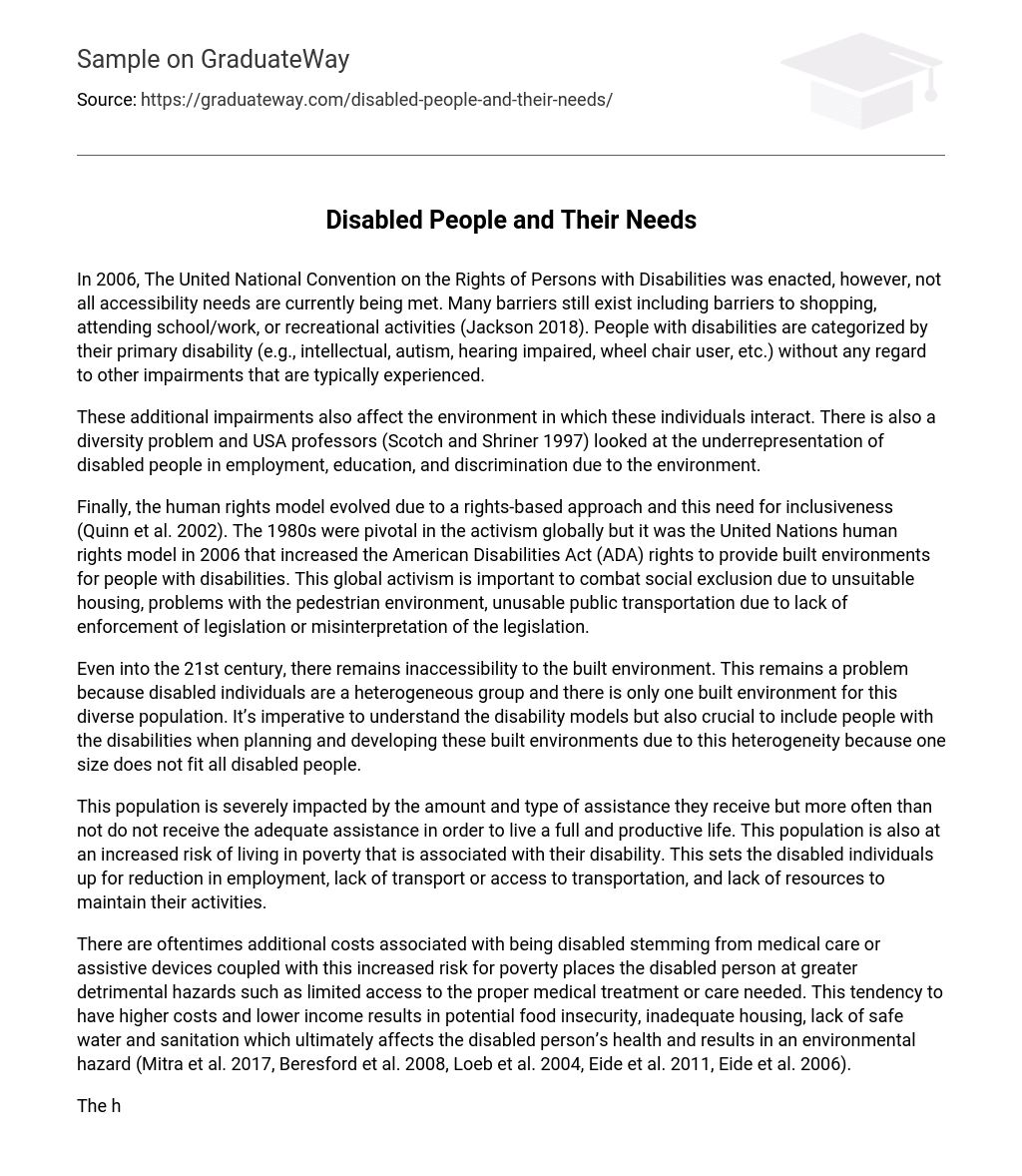In 2006, The United National Convention on the Rights of Persons with Disabilities was enacted, however, not all accessibility needs are currently being met. Many barriers still exist including barriers to shopping, attending school/work, or recreational activities (Jackson 2018). People with disabilities are categorized by their primary disability (e.g., intellectual, autism, hearing impaired, wheel chair user, etc.) without any regard to other impairments that are typically experienced.
These additional impairments also affect the environment in which these individuals interact. There is also a diversity problem and USA professors (Scotch and Shriner 1997) looked at the underrepresentation of disabled people in employment, education, and discrimination due to the environment.
Finally, the human rights model evolved due to a rights-based approach and this need for inclusiveness (Quinn et al. 2002). The 1980s were pivotal in the activism globally but it was the United Nations human rights model in 2006 that increased the American Disabilities Act (ADA) rights to provide built environments for people with disabilities. This global activism is important to combat social exclusion due to unsuitable housing, problems with the pedestrian environment, unusable public transportation due to lack of enforcement of legislation or misinterpretation of the legislation.
Even into the 21st century, there remains inaccessibility to the built environment. This remains a problem because disabled individuals are a heterogeneous group and there is only one built environment for this diverse population. It’s imperative to understand the disability models but also crucial to include people with the disabilities when planning and developing these built environments due to this heterogeneity because one size does not fit all disabled people.
This population is severely impacted by the amount and type of assistance they receive but more often than not do not receive the adequate assistance in order to live a full and productive life. This population is also at an increased risk of living in poverty that is associated with their disability. This sets the disabled individuals up for reduction in employment, lack of transport or access to transportation, and lack of resources to maintain their activities.
There are oftentimes additional costs associated with being disabled stemming from medical care or assistive devices coupled with this increased risk for poverty places the disabled person at greater detrimental hazards such as limited access to the proper medical treatment or care needed. This tendency to have higher costs and lower income results in potential food insecurity, inadequate housing, lack of safe water and sanitation which ultimately affects the disabled person’s health and results in an environmental hazard (Mitra et al. 2017, Beresford et al. 2008, Loeb et al. 2004, Eide et al. 2011, Eide et al. 2006).
The health of the disabled individual may be detrimentally impacted due to the built environment. The ADA was established in 1990 and health care reform known as the Affordable Care Act (ACA) in October 2013 required every state to offer health insurance for individuals. The ADA provided access to built environments for people with disabilities. The health care system in the United States is geared towards meeting the short-term needs or acute needs of individuals. People with disabilities often need long-term services and support to address their chronic health needs.
These needs often times include aiding with activities of daily living, taking medications, preparing meals, managing money, obtaining employment, and individual needs based on their specific disability. There may be multiple disabilities which impact these needs even more severely. Most of the long-term service expenses are provided out-of-pocket by the families and can range from $6,000 to $16,000 annually depending on the disability (Mitra et al. 2017).
There are only about 9% of the United States population that have long-term care insurance and Medicare only provides a limited amount of long-term care coverage (Mitra et al. 2017). Medicaid does provide long-term care coverage but primarily goes to fund institutional care. People who want to receive their coverage in community settings are not entitled to home or community-based services.
This becomes a problem for people who have disabilities who are higher functioning but still need the additional medical care or services. Also, the problem with the ADA is that this regulatory act has resulted in a lack of fit because the disability population is heterogeneous and not homogeneous. There are around 40 million Americans in 2015 with a disability according to the U.S. Census Bureau. This represents almost 13% of the civilian non-institutionalized population.
In order to be classified as a person with a disability, the person must have one of the six classifications: difficulty with hearing, vision, cognition, walking, or climbing stairs, as well as difficulty with self-care and independent living (Pew Research, 2017). This population continues to grow and affects millions of people. The barriers of inclusiveness are as varied as the disabilities themselves.
Another barrier that institutions and organizations need to address is access to health care services. There may be unintentional barriers placed upon someone with disabilities due to complicated booking systems to actually receive health care, problems with arriving early and/or staying all day (Miller 2004). We have all experienced arriving at the health care facility on-time only to have to forfeit hours of your day waiting to be seen.
This inconvenience may be exacerbated depending on the disability the individual may have. Funding may also be a deterrent as reimbursement to providers doesn’t account for additional time required for services for people with disabilities. Since reimbursement is typically a fixed amount, it might discourage providers from providing service (Smith 2000). Depending on the transportation needs and access to medical facilities that will provide services to disabled people may amplify this environmental barrier.
There are five kinds of environmental barriers that people with disabilities face. These barriers include dependence on individuals, the disability of the individual, and other things that may affect the individual. The primary barriers include physical barriers, attitude barriers, assistance barriers, policy barriers, and work and school barriers (Hospital, Brainline).





